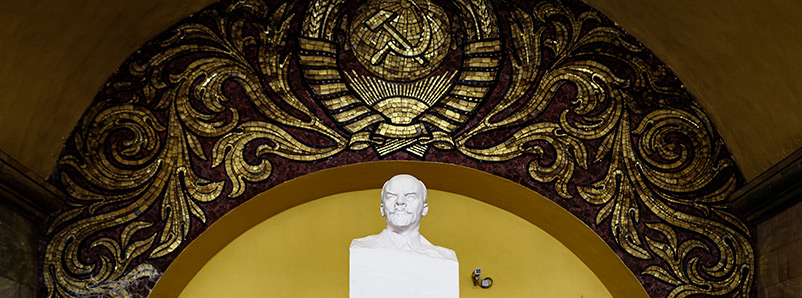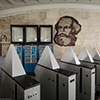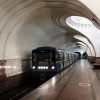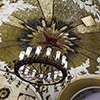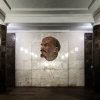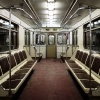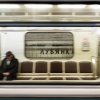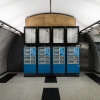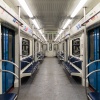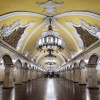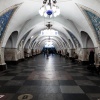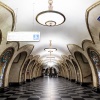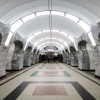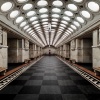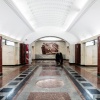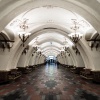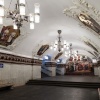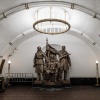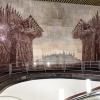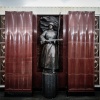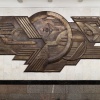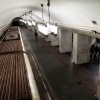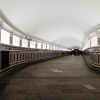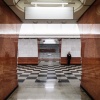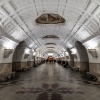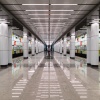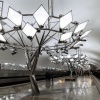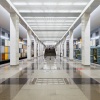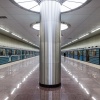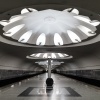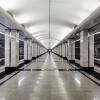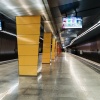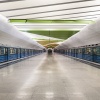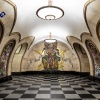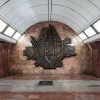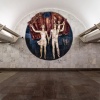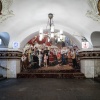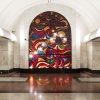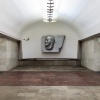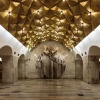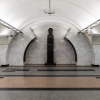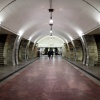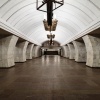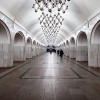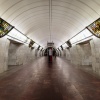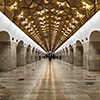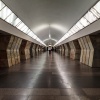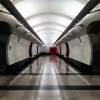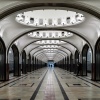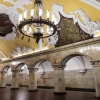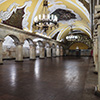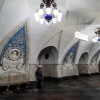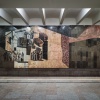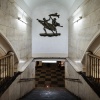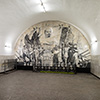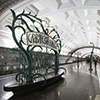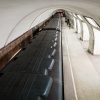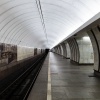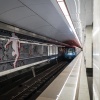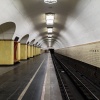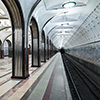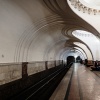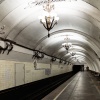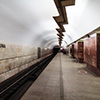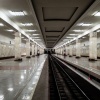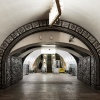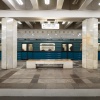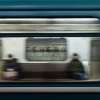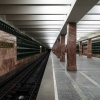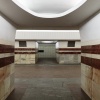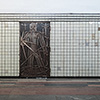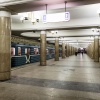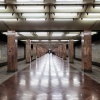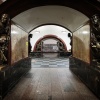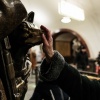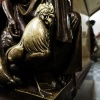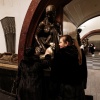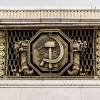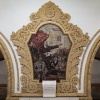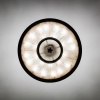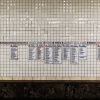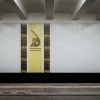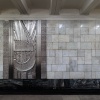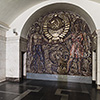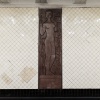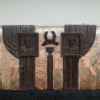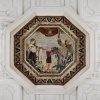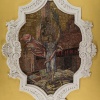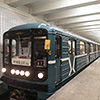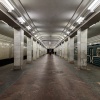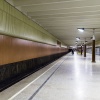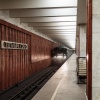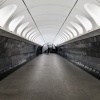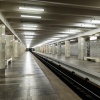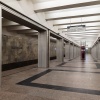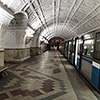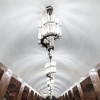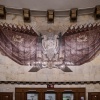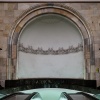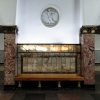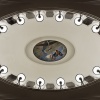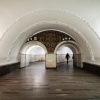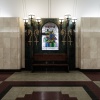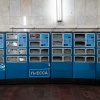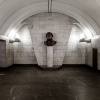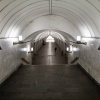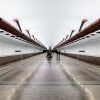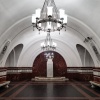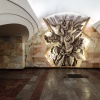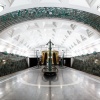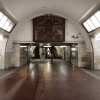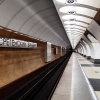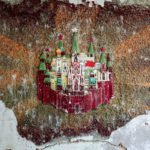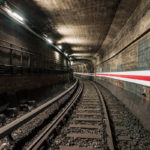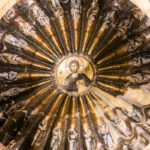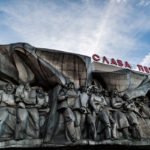Moscow Metro – Queen of Undergrounds
I can still feel the New Year’s party on Red Square in my bones; the very square that was said to be entirely closed if one would believe the words of western media. Well, I had quite a great midnight, enjoyed the fireworks and ice-skating together with Russians, Georgians and Armenians before going underground to captue the whole Moscow Metro. Daytime temperatures meanwhile reached thrilling -21°C, a profound coldness that’s literally made for Banya visits and wearing thick leather coats. Each morning at 6 o‘clock I left my domicile on Bolshaya-Grusinskaya street, the big Georgian, and walk through the snow towards Barrikadnaya station to enter the Moscow Metro to document and portrait the architecture of all its lines and station.
This article is an excerpt of a bigger photo series
››› Here is the entire photo series of all stations & lines of Moscow Metro 📷
Moscow Metro – The Underground of the Russian Capital
Alltogether Moscow has 12 metro lines and fortunately Frunzenskaya (Фрунзенская) was still open when I started capturing the metro as only a few days later this station got closed due to reconstruction works lasting longer than a year. I was lucky again as such reconstruction works recently ended for Baumanskaya station (Бауманская), hence both stations could be part of the project like Tekhnopark (Технопарк), that was the youngest station back then in January 2016.
The short interval of succeeding trains helps a lot to capture the metro as between 6 and 9 o’clock it was looking quite deserted. After 9 o’clock things get more difficult and you feel that unofficial 15 million people inhabit Moscow. And I even took advantage of the national holidays between New Year and orthodox Christmas, when many people leave the city.
The very short train interval is also something letting the hearts of my BVG friends beat stronger. They are positively jealous, as it’s a technical masterpiece to run a metro in such free of interferences and disturbances. Here in Berlin it’s actually order of the day that some drunk tard walks in the rails, or applies the emergency brake, or or or. In Moscow you won’t meet such annoyances often.
Already 2007, when I visited the Russian capital for the first time, I wanted to capture the metro. Its underground palaces show a worldwide unique style and iconography, and are made from noble materials such as marble or granite. If you ride into town then announcements come from a male voice. If you leave the capital again then all station messages are spoken by a woman. Why? To give blind passengers a better orientation where they are and move to. Clever, eh?
All in all three major architecture eras got featured in the Moscow Metro and become apparent. Classicistic, even Greek appearing underground halls like for example Komsomolskaya (Комсомольская), or functional-cubic stations being carried by two rows of columns, something you can easily see at Molodyozhnaya (Молодёжная) station and of course modern style architecture, involving daylight inlets and materials such as glass and steel, as stations Lermontovsky Prospekt (Лермонтовский проспект) or Volokolamskaya (Волоколамская) exemplify.
One central stylistic device is a common thing between all Moscow Metro stations though, that is an unbelievable symmetry. If you stand at the end of a station hall and in the middle, then your sight will disappear in infinity, being led by endless lines. Other often used stylistic devices are murals, either painted or even cast in concrete or metal, as well as busts and even statues; and that’s how famous Pushkin stares into the never ending flow of millions of Moscow passengers like Lenin, Turgenev, Dostoyevsky or the Belorussian partisans do.
The numbers of the metro lines more less correlate with their opening; meaning that line 1 was the first ever. Having a leg to Smolenskaya station (Смоленская), it basically ran between Sokolniki (Сокольники) and Park Kultury (Парк Культуры). Already in 1934 some 75.000 workers were involved to finish the first Socialist as well as Soviet underground rail. Until its opening on May 15th, surely even more workers were in charge of completion.
Completion of the Moscow Metro consumed 21% of Russia’s annual budget; also because noble materials such as marble and granite got used. Though, the metro is not a through and through Socialist thing as meeting the deadline was only possible due to buying an English shield tunnelling machine. Construction works resulted in a first metro line being 11.2 km long as well as 2.3 million m² of overburden and 842.500 m² of poured concrete.
Preserved Russian-Soviet History
Monument protection has highest priority, hence Frunzenskaya and Baumanskaya got recently reconstructed. The metro stations are monuments and are advertising-free, what is pure relief for western eyes being in a state of constant advert overload. And there is another very charming and heart-winning detail: the majority of station names ends with „-aya“ – what is a tribute to women :-)
Many visitors of Moscow almost instantly notice, that the metro of the Russian capital is quite clean, leaving for example Berlin far behind, where it’s easy to walk in a pile of human shit at U7 station Hermannplatz, or to meet a puddle of sick inside M10 (party) tram and Berlin’s S-Bahn trains are not really better, as sometimes they smell terrible from the last bum spending the night in there. Against the background that Russians like Vodka, it is a surprising contrast that Moscow is much cleaner than Berlin.
For the Muscovites their metro is a main artery. Deep down in the bowels of Moscow there is no traffic jam like it’s often the case above ground. The metro just always runs. To boot it is an inherent part of the city, it is fully accepted, what gets revealed when people make appointments as they always meet in and at metro stations.
“14 o’clock Kitay-Gorod, then 19 o’clock at Smolenskaya, ok?” That’s a very usual way to make appointments, hence the middle of the platform is packed with people waiting for people. Also free Wi-Fi plays an important role and explains why so many people are down in the metro. They’re simply surfing :-)
Giants in the Underground
Another very cute Muscovite tradition is to touch the dog’s nose, one of the bronze statues inside Ploshchad Revolyutsii station (Площадь Революции), the Revolution Square. Also touching the cock’s back is a luck charmer. Hence millions of hands per month pet the artificial animals as the Moscow Metro, with its 333 kilometres in length and 200 stations, has the highest passenger volume not only in Europe but also in the world.
Belonging to the oldest and largest stations, the stations of circular line Koltsevaya (Кольцевая) have a special rank as they got all built in Stalin era in Socialist Realism style. Along the line’s course you can find the 190 metres stretching colossal Komsomolskaya (Комсомольская) as well as lovely Kiyevskaya (Киевская), with its murals showing Ukraine rural scenes. Another gem is Novoslobodskaya (Новослободская) with its elegantly curves lines, shapes and glass mosaics being dedicated to art, in particular music. Of course the Great Patriotic War is a central theme of Moscow Metro. At Taganskaya (Таганская) that historic landmark becomes apparent when blue-backed wall medallions tell the story of soldiers and heroes.
Willingness to cooperate and enthusiasm of the Russians was big when they heard of my project. In fact they swept me off my feet as I’ve rarely seen so much constructivity, ideas and suggestions. Barely having put the photo series online, I got officially featured by MosGorTrans, by Moscow’s major in chief Oberbürgermeister as well as by youth magazine Bolshoj Gorod. My photo series inspired Russian DJ Dr.Spy.Der (known as headliner of Kazantip Festival or Krysha Mira Club) to produce a techno track dedicated to Moscow Metro.
In July 2016 I returned to Moscow. Everywhere are construction sites, in particular wide Tverskaya road and Tverskoy Boulevard are one giant building site. I use the opportunity to capture the newest two stations being put into operation since January, that is Rumyantsevo (Румянцево) and Salaryevo (Саларьево). I came to Moscow to meet very good friends and to attend to final ceremony of Golden Turtle photo competition, that I won in “Human and Nature” category. Surely it wasn’t my last visit to thrilling Moscow :-)
